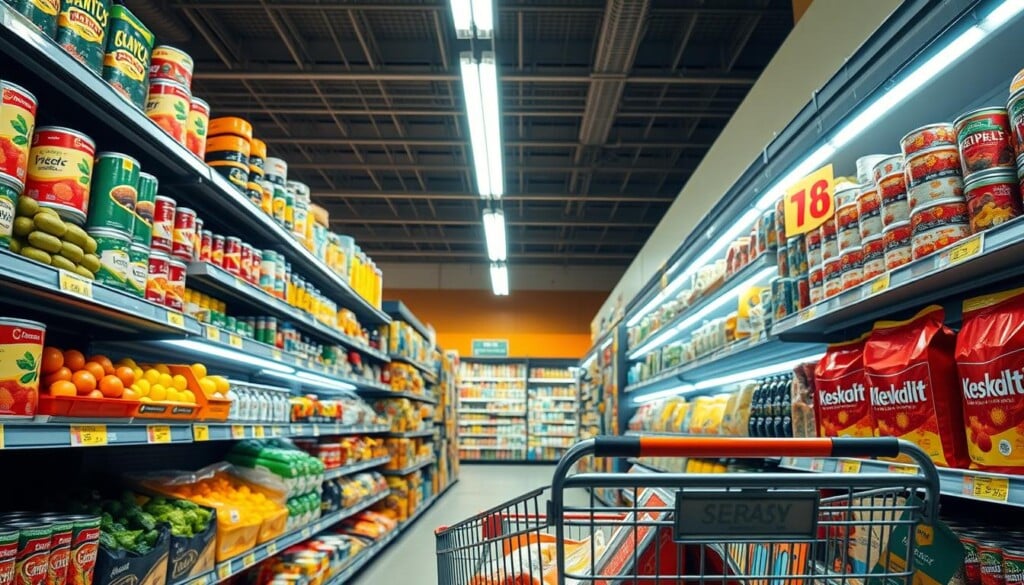Have you ever thought about how your grocery shopping affects your community and health? Today’s grocery stores are more than just places to buy food. They offer fresh produce, organic choices, and support for the community.
As people look for easy access to quality items at good prices, local stores become key. LocalZ helps you find these stores in your area, making it easy to shop locally.
Key Takeaways
- Local grocery stores offer fresh produce and organic options.
- Convenient locations enhance the shopping experience.
- Supporting local businesses strengthens community ties.
- Access to affordable prices is a priority for shoppers.
- LocalZ simplifies the search for nearby grocery stores.
Why Choose Local Grocery Stores?
Choosing local grocery stores is key to a vibrant community. By shopping here, you help support local efforts and economies. These stores offer fresher and unique items that big chains can’t match.
Supporting Your Community
Shopping at local stores boosts the local economy. This helps create jobs and opportunities. It also makes it easier to support community projects.
Spending at local stores benefits local farmers and producers too. It’s a positive effect that spreads far.
Fresh and Local Produce
Local stores sell fresh produce from nearby farms. This produce tastes better and is of higher quality than what big chains offer. Choosing local helps support sustainable farming and a healthier lifestyle.
Convenience and Accessibility
Shopping at local stores is convenient and accessible. They’re often close by, saving time and reducing traffic. You get a quicker shopping experience, making these places great for daily needs.
How LocalZ Connects You to Grocery Stores
LocalZ is an online directory that makes finding grocery stores easy. It helps users locate stores in their area. Whether you need fresh produce, canned goods, or specialty items, LocalZ has you covered.
A Comprehensive Online Directory
This directory lists many grocery stores. It’s a great tool for those who want to shop locally. LocalZ organizes stores by location, products, and ratings. This makes shopping better and supports the community.
Easy Search and Filter Options
The platform offers advanced search and filter tools. These tools help users narrow down their search. You can look for stores based on price or specific products. This makes choosing groceries easier.

Benefits of Shopping at Local Grocery Stores
Shopping at local grocery stores offers more than just convenience. They provide high-quality products that often beat what big chain stores offer. Shoppers find that local goods are fresher and taste better, making grocery shopping more enjoyable.
High-Quality Products
Local stores are proud to sell products from local farmers and artisans. This means the food is not only delicious but also healthier. You can be sure you’re getting the best, as it’s picked at its peak freshness.
Unique Local Offerings
Local stores also offer unique items you won’t find elsewhere. From handmade goods to special organic products, they showcase the community’s flavors and traditions. This variety lets shoppers try new things, making their shopping trips more exciting.
Navigating LocalZ for Grocery Store Listings
Using LocalZ makes it easy to find grocery stores that fit your needs. It offers a simple way to find what you’re looking for quickly.
Step 1: Search for What You Need
Start by typing what you need in the search bar on LocalZ. You can look for specific items or types of groceries. This search gives you a list of stores that can meet your shopping needs.
Step 2: Filter and Choose the Best Options
Once you have your search results, it’s time to filter them. You can sort by location, product type, and price. This helps you find the best grocery stores for you.
Step 3: Access Customer Reviews
Reading customer reviews is key to making good choices. They tell you about the quality and trustworthiness of different stores. By reading these reviews, you can make better decisions when shopping on LocalZ.
Exploring Popular Grocery Store Chains
When it comes to grocery shopping, there are many options. Chains like Whole Foods, Trader Joe’s, and Safeway each have their own strengths. Knowing what each offers can make shopping better.
Whole Foods Market
Whole Foods Market is a top choice for organic and natural foods. It’s perfect for those who want the best ingredients. With a wide range of organic and specialty items, it’s a go-to for a healthy diet.
Trader Joe’s
Trader Joe’s is known for its unique products and good prices. It’s loved for its fun shopping vibe and special finds. It’s great for families who want to try new foods without breaking the bank.
Safeway
Safeway is great for everyday shopping. It has a wide selection and regular sales. It’s a convenient place to find everything from fresh produce to household items. Customers often find great deals here.
The Rise of Hyperlocal Digital Platforms
Hyperlocal platforms have changed how we connect with local businesses. They meet community needs with digital solutions. Companies like LocalZ are leading this change, making it easier for local services to grow.
Meeting Community Needs
Hyperlocal platforms are key in meeting community needs. They offer localized services that fit into our daily lives. This helps locals support nearby businesses, thanks to platforms like LocalZ.
Building Stronger Connections
Stronger connections are essential for local economies. Hyperlocal platforms help businesses and residents connect. This builds a sense of community and supports the local economy.

LocalZ’s Commitment to Local Development
LocalZ puts a big focus on helping local communities grow. They do this by getting involved and investing in local projects. This helps the local economy, making life better for both people and businesses.
Supporting Local Organizations
LocalZ also helps out local groups that are key to community growth. They work with non-profits and community groups to tackle local problems. This way, everyone in the community can feel the benefits of local businesses.
This approach brings people together. It encourages them to help make their neighborhoods better.
Responsibility through Listing Fees
LocalZ has a unique way of doing business. They give 50% of their listing fees to local organizations. This shows their commitment to helping the community and promoting green business practices.
By putting money back into the community, LocalZ shows it’s dedicated to making things better. This helps improve the community’s well-being and gets more people involved.
Tips for Finding the Best Grocery Deals
Finding great grocery deals can make shopping more fun and save you money. There are many ways to stretch your budget and get fresh products. Seasonal sales and loyalty programs are key to saving.
Seasonal Sales
Seasonal sales happen all year, giving you chances to save on certain items. Stores often cut prices on holiday items or fresh fruits and veggies when they’re in season. Watching for these sales can help you save a lot and fill your pantry with good stuff at lower prices.
Loyalty Programs
Many stores have loyalty programs that reward shoppers. By joining these, you can get special deals or discounts on your next buys. Each store’s program is different, but they all give points for frequent shopping. These points can add up to big savings over time.

Join the LocalZ Community Today!
Joining LocalZ offers many benefits for local businesses looking to grow. The sign-up process is easy, letting you create an account fast. This connects your business to a wide network of customers and highlights your offerings.
How to Sign Up
To join LocalZ, just go to the sign-up page. There, a simple form asks for your business details. In just a few minutes, you can start promoting your local products and services.
Once you’re registered, you get access to tools that help you connect with local customers. This makes it easier to reach people who are looking for local solutions.
Benefits of Being a Local Partner
Being part of LocalZ brings many benefits. You get more exposure to a targeted audience. This helps your brand become more visible and builds loyalty among customers.
Plus, being on a platform focused on local development puts your business in a great spot. It aligns with the growing trend of community-focused shopping.

